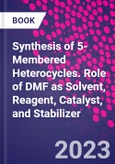Synthesis of Five-Membered Heterocycles: Role of DMF as Solvent, Reagent, Catalyst, and Stabilizer helps readers quickly assess possible synthetic approaches. The book's audience, researchers, academic professionals and synthetic chemists both in industry and academia will find detailed information about the synthesis of five-membered heterocyclic compounds using dimethylformamide. Over the years, heterocyclic compounds, especially five-membered, have drawn more attention of pharmaceutical community because of their therapeutic value. The formation of heterocyclic compounds has turned out to be the keystone of synthetic organic chemistry.
Dimethylformamide has played an important role in organic synthesis for a long time, and it is frequently utilized as a common solvent for chemical reactions and broadly used in industry as a reagent. It is a unique chemical and can play three other roles in organic chemistry, i.e., as stabilizer, reagent and catalyst. Due to its structure, DMF can participate in several reactions as a versatile building block for several units.
Please Note: This is an On Demand product, delivery may take up to 11 working days after payment has been received.
Table of Contents
1. Synthesis of pyrroles2. Synthesis of fused pyrroles
3. Synthesis of isoindoles and indoles
4. Synthesis of fused indoles
5. Synthesis of indolizines and azaindoles
6. Synthesis of pyrazoles
7. Synthesis of imidazoles and benzimidazoles
8. Synthesis of triazoles, benzotriazoles, and tetrazoles
9. Synthesis of furans, benzofurans, and dioxolanes
10. Synthesis of isoxazoles, oxazoles, and oxadiazoles
11. Synthesis of thiophenes
12. Synthesis of thiazoles, benzothiazoles, and thiadiazoles








